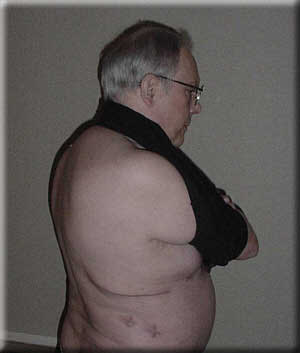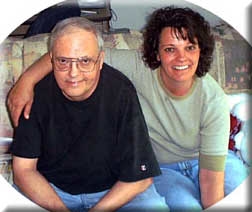Mesothelioma Tests Mettle
Robert "Dusty" Rhodes, a 63 year-old Navy veteran and former steelworker from Crown Point, Indiana, can take the heat. He worked more than two decades at the massive Inland Steel mill in East Chicago, Indiana. Temperatures at the soaking pits held steady at thousands of degrees. Dusty's mettle now faces the test of mesothelioma after his diagnosis in December, 2001.
ONE JOURNEY LEADS TO ANOTHER
It was October 2001, and Dusty was on vacation with his girlfriend, Connie. The two were in her van, driving around the historical sites of the East Coast and Appalachia. Dusty and Connie made these autumn trips around various parts of the United States every year. With its brilliant display of colors, the onset of fall is Dusty's favorite time of the year to travel. In 2000, he and Connie visited Wisconsin; in 1999, they visited Washington, DC, returning home by way of Skyline Drive in the Shenandoah Mountains. This year, they were visiting the homes of various presidents from James Madison to Thomas Jefferson. However, a trip that should have been enjoyable became increasingly unbearable, as Dusty endured breathing trouble that increased in severity with each passing day. Breathing while laying down became extremely difficult, and chest pain developed as well.
Upon returning home at the end of their three-week journey, Dusty decided to see a doctor. He met with his physician, and a chest film revealed a right-sided pleural effusion. In November, he was admitted to St. Anthony's Hospital in Crown Point where doctors removed nearly two quarts of fluid from his right thoracic cavity. Cytological testing on the fluid revealed clusters of mesothelial cells with mild atypia. Further testing was recommended.
On December 6, 2001, Dusty underwent a thoracotomy with biopsy. Pathological tests on frozen sections of parietal and visceral pleura as well as a wedge resection of the right lower lobe were positive for malignancy. Immunohistochemical staining confirmed the diagnosis of malignant mesothelioma.
THE QUEST FOR TREATMENT
Dusty then consulted with a pulmonologist as well as an oncologist. His oncologist recommended that he consult with Dr. Hedy Kindler at the University of Chicago in Illinois. After an initial examination, Dr. Kindler recommended an echocardiogram before settling on a treatment path.
 To supplement his existing efforts to find treatment, Dusty consulted with Dr. Harvey Pass of the Karmanos Cancer Institute in Detroit, regarding more aggressive treatment regimens such as surgical resection of the tumor or chemotherapy with Adriamycin. Dr. Pass examined the results of Dusty's physical exams to determine his eligibility for these treatments, but was forced to inform him that because of his weak heart, the risk of mortality from the treatments was too high to follow any of these treatment paths.
To supplement his existing efforts to find treatment, Dusty consulted with Dr. Harvey Pass of the Karmanos Cancer Institute in Detroit, regarding more aggressive treatment regimens such as surgical resection of the tumor or chemotherapy with Adriamycin. Dr. Pass examined the results of Dusty's physical exams to determine his eligibility for these treatments, but was forced to inform him that because of his weak heart, the risk of mortality from the treatments was too high to follow any of these treatment paths.
Dusty is still consulting with Dr. Kindler as he tries to stave away the pain. Among his regimen of pain medications are several prescription pain-killers, but despite his efforts, the pain remains quite severe. Additionally, Dusty tires easily, and uncertainty about the future weighs heavily on him. His predicament is not enviable -- he states that he wants to treat his pain and what causes it, yet his body is too weak to withstand the treatment. He goes on to say that he is not one to harbor resentment, but even he admits that his sporadic yet severe anxiety about his condition was never something he anticipated nor desired having to contend with. He feels that all people, regardless of their station, should be held accountable for their actions, as each action has a consequence that will affect the life of someone else.
PLANNING WITH AN UNCERTAIN FUTURE
His daughter, Lori, his son-in-law, James, and his four grandchildren offer their support, and that helps him get through each day. Additionally, the lifelong Cubs and Bears fan holds onto the possibility that he might be able to again make the 50-mile trek to Wrigley field and see the Cubs take on the Yankees in a World Series, or see the Bears play at hallowed Soldier Field. Or, if he is able, he would hop in the van with Connie again and drive someplace new with the onset of next fall.
We will keep you posted on Dusty's journey.
*** POSTED MAY 6, 2002 ***


